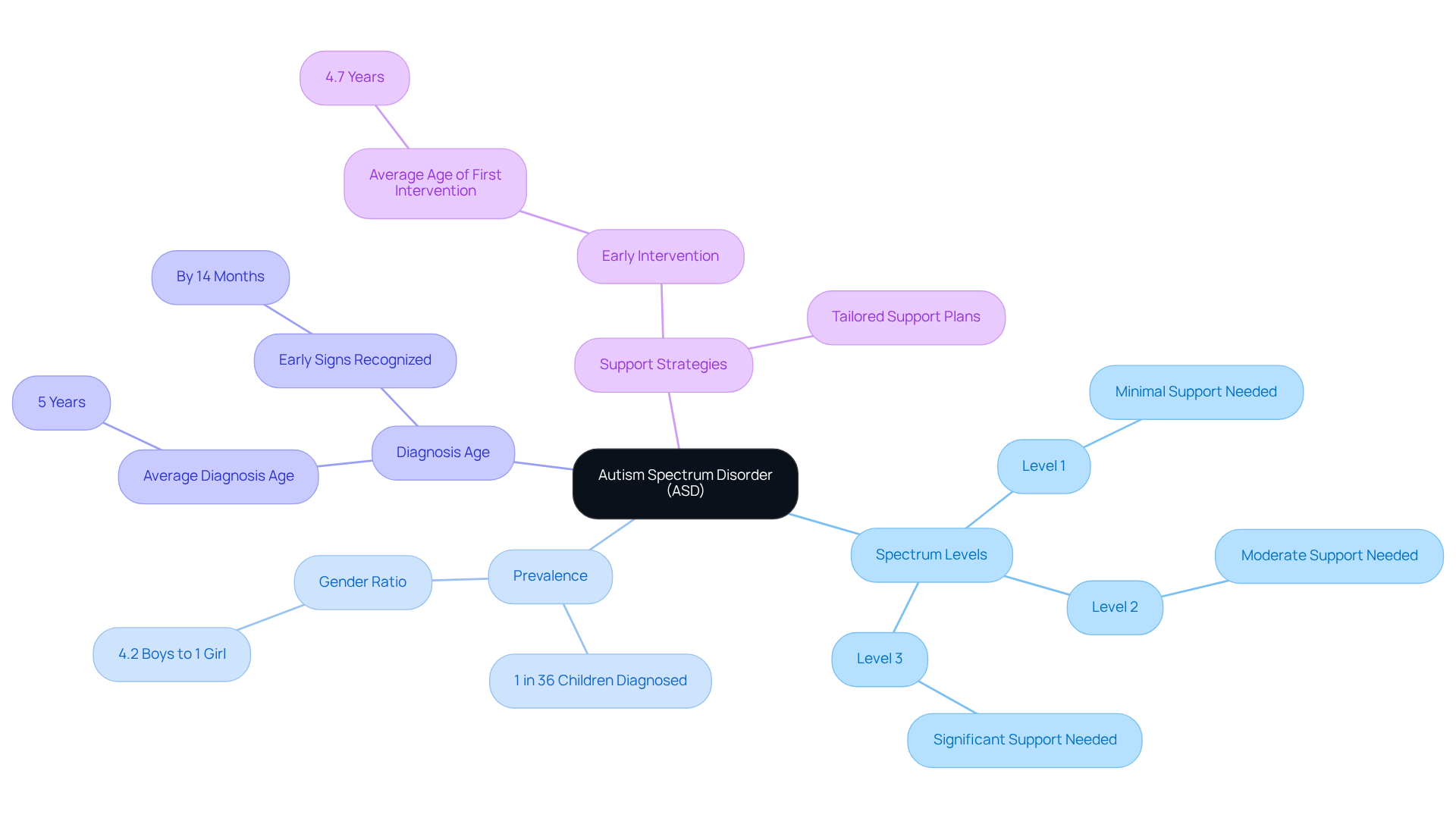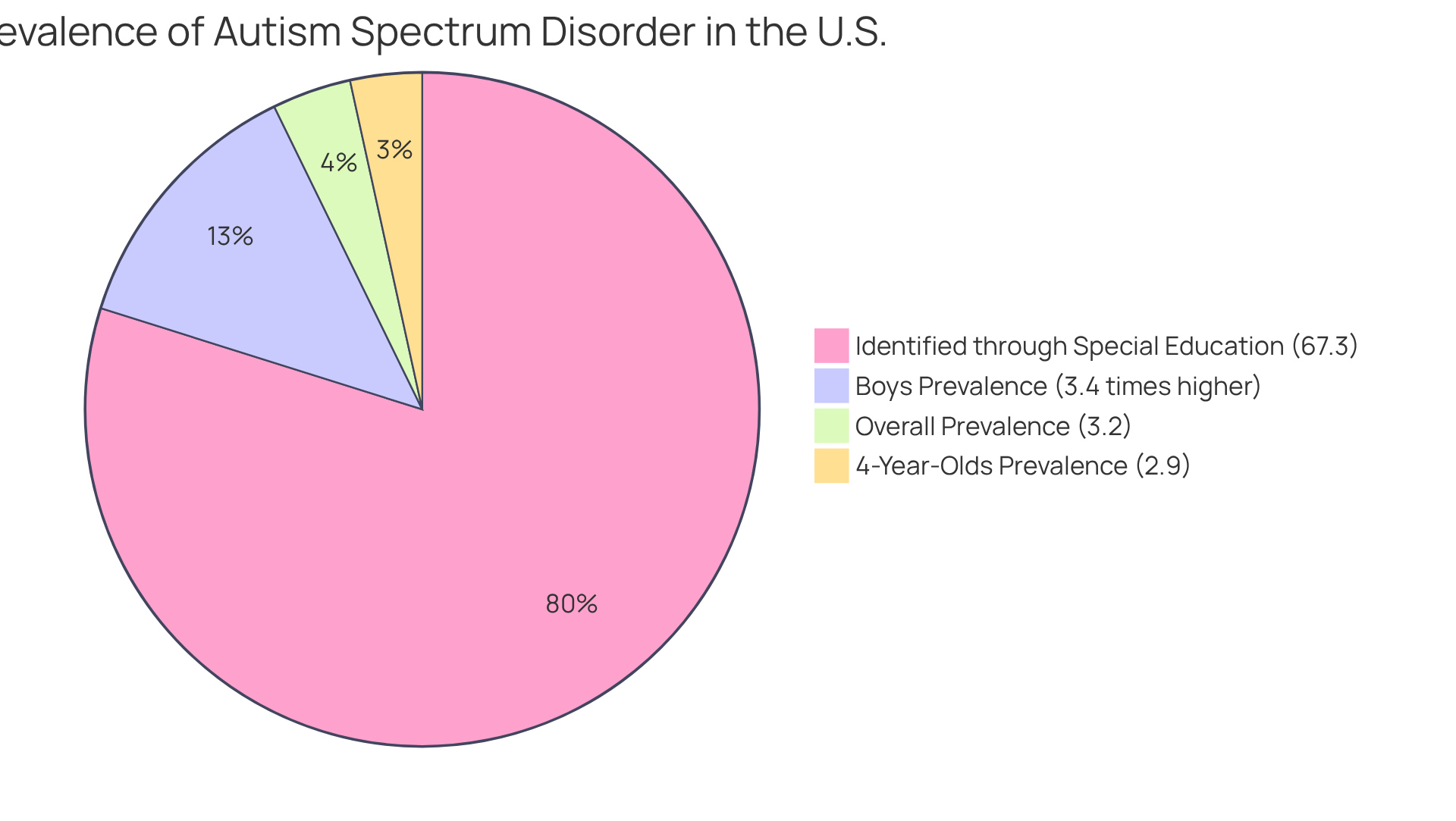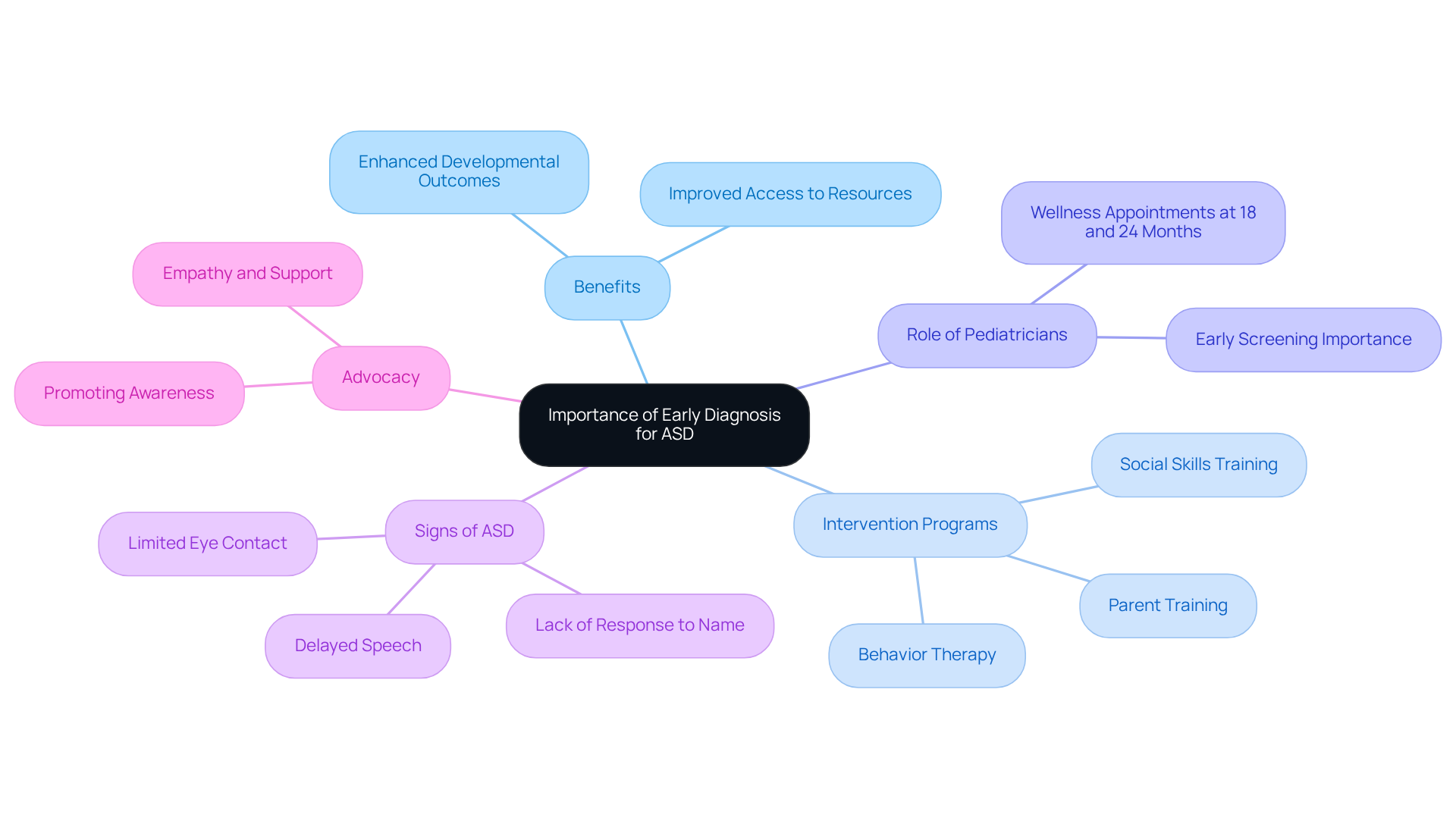Overview
The prevalence of Autism Spectrum Disorder (ASD) is a significant concern, with approximately 1 in 36 children in the U.S. diagnosed with the condition. Notably, higher rates are observed in boys, which can be a source of worry for many parents. Understanding this reality is the first step in addressing the needs of our children.
Early diagnosis and intervention are crucial. Timely support can make a profound difference in enhancing developmental outcomes for affected children. As parents, it’s essential to recognize the signs and seek help as soon as possible. Together, we can create a nurturing environment that fosters growth and understanding.
If you have experiences or insights to share, please consider joining the conversation in the comments or through our newsletter. Your stories matter, and they can help others navigate this journey with compassion and hope.
Introduction
Understanding Autism Spectrum Disorder (ASD) is essential in a world where approximately 1 in 36 children are diagnosed with this complex developmental condition. This statistic serves as a reminder of the importance of awareness and compassion in our communities. The spectrum of autism encompasses a variety of symptoms and support needs, which makes it crucial for caregivers and professionals to recognize and address these differences effectively. Yet, with rising prevalence rates and significant disparities in diagnosis—especially among boys—how can families and communities ensure that every child receives the appropriate support they deserve?
This article delves into the latest statistics, the importance of early diagnosis, and the vital role of tailored interventions in fostering a supportive environment for children with autism. Together, we can explore the challenges faced by families and the resources available to help navigate this journey. Let’s work towards ensuring that every child on the spectrum receives the understanding and support they need to thrive.
Define Autism and Its Spectrum
Autism Spectrum Disorder (ASD) is a complex developmental condition that can present unique challenges in social communication, interests, and behaviors. The term 'spectrum' reflects the wide range of symptoms and severity that individuals may experience. For example, children diagnosed with Level 1 ASD often need minimal support, while those at Level 3 may require significant assistance with daily activities. Recognizing this diversity is crucial for understanding the varying needs of individuals on the spectrum, enabling us to develop tailored support strategies.
Recent research indicates that approximately 1 in 36 children in the U.S. are diagnosed with ASD, which raises the question of how many kids are autistic, with a notably higher prevalence in boys, who are identified at a rate of about 4.2 to 1 compared to girls. The typical age for diagnosis is around 5 years, although signs can often be recognized as early as 14 months. Identifying these characteristics and understanding the different levels of support required is vital for caregivers and professionals navigating the complexities of developmental disorders and seeking effective interventions.
Moreover, it's important to note that about 1 in 6 children aged 3-17 years have been identified with a developmental disability, illustrating the broader context of autism's impact. By fostering awareness and understanding, we can better support individuals with ASD in reaching their full potential. We encourage you to share your experiences and insights, as together we can create a more supportive environment for those on the spectrum.

Examine Current Autism Prevalence Statistics
Recent data from the CDC reveals a concerning trend about how many kids are autistic: approximately 1 in 31 young individuals (3.2%) in the United States is identified with Autism Spectrum Disorder (ASD) by age eight. This marks a significant increase from previous years, highlighting the critical importance of early diagnosis and intervention. For instance, among 4-year-olds, reports indicate how many kids are autistic is at a prevalence of 1 in 34. Such statistics not only inform us but also urge us to enhance awareness and resources for families in need.
It’s particularly noteworthy that boys are diagnosed at a much higher rate, with a prevalence of 3.4 times that of girls. This disparity calls for a deeper understanding of the factors at play. Moreover, regional inequalities are evident, with states like New Jersey reporting some of the highest rates, raising questions about how many kids are autistic, where 1 in 29 youths are recognized with the condition. These variations in diagnosis rates remind us of the essential role local advocacy plays in securing the necessary systems and resources for families navigating the complexities of autism care.
A significant aspect to consider is that 67.3% of youngsters with developmental disorders were identified through special education eligibility. This underscores the vital role schools play in the identification process, providing a support network for affected families. Additionally, 39.6% of youths with developmental disorders also face simultaneous intellectual disabilities, complicating their care and support needs.
As Dr. Alice Kuo highlights, the higher mortality rates among autistic individuals further emphasize the urgency of addressing these issues. It's a call to action for all of us to advocate for better resources and support systems. Together, we can work towards a future where every child receives the care and understanding they deserve.

Understand the Importance of Early Diagnosis and Evaluation
Early diagnosis and evaluation of Autism Spectrum Disorder (ASD) are crucial for optimizing developmental outcomes. Did you know that studies show individuals diagnosed before the age of 2.5 experience significant enhancements in their developmental scores compared to those diagnosed later? This highlights the importance of early intervention programs, like those offered by Circle Care Services. These programs focus on enhancing communication and social interaction skills, which are vital for overall development.
Circle Care Services provides a comprehensive support system that includes:
- Parent training
- Social skills training
- Behavior therapy
This approach aims to equip families with the tools they need to support their children effectively. Pediatricians play an essential role in this process, examining youngsters during wellness appointments at 18 and 24 months, as recommended by the American Academy of Pediatrics. Early screening is vital for identifying children who may benefit from intervention, as pediatricians emphasize.
As parents, it’s important to be vigilant for early indicators of ASD, such as:
- Limited eye contact
- Lack of response to their name
- Delayed speech
Recognizing these signs and seeking prompt assessments can lead to improved assistance and resources for children and their families. This, in turn, fosters a more inclusive environment for individuals on the spectrum.
Temple Grandin, a passionate advocate for awareness of developmental disorders, beautifully captures the essence of understanding and supporting children with autism by stating, 'I am different, not less.' This perspective serves as a reminder of the value of early recognition and the importance of nurturing children with autism from a young age.

Conclusion
Understanding Autism Spectrum Disorder (ASD) is essential, as it affects approximately 1 in 36 children. This statistic highlights the urgent need for awareness and tailored support. The complexity of autism, characterized by its diverse range of symptoms and varying support requirements, underscores the importance of recognizing these differences to provide effective interventions. By fostering an inclusive environment, families and communities can ensure that every child on the spectrum receives the understanding and care they deserve.
This article has delved into critical aspects of autism, including current prevalence statistics, the significance of early diagnosis, and the essential roles that parents and educational institutions play in supporting affected children. It is particularly concerning that boys are diagnosed at a much higher rate than girls, emphasizing the need for targeted awareness and resources. Moreover, the benefits of early intervention cannot be overstated; timely support can lead to significantly improved developmental outcomes for children with ASD.
In light of this information, it is crucial for communities to advocate for better resources and support systems for families navigating autism care. By raising awareness and sharing experiences, individuals can contribute to a more supportive environment for those on the spectrum. Everyone has a role to play in ensuring that every child is given the opportunity to thrive, reinforcing the message that understanding and compassion are key to fostering an inclusive society.
Frequently Asked Questions
What is Autism Spectrum Disorder (ASD)?
Autism Spectrum Disorder (ASD) is a complex developmental condition characterized by unique challenges in social communication, interests, and behaviors.
What does the term 'spectrum' mean in relation to autism?
The term 'spectrum' refers to the wide range of symptoms and severity that individuals with autism may experience, with varying levels of support needed.
What are the different levels of ASD and their support needs?
Individuals diagnosed with Level 1 ASD typically need minimal support, while those at Level 3 may require significant assistance with daily activities.
How prevalent is ASD among children in the U.S.?
Approximately 1 in 36 children in the U.S. are diagnosed with ASD, with a higher prevalence in boys at a rate of about 4.2 to 1 compared to girls.
At what age is autism typically diagnosed?
The typical age for diagnosis of autism is around 5 years, although signs can often be recognized as early as 14 months.
What percentage of children aged 3-17 years are identified with a developmental disability?
About 1 in 6 children aged 3-17 years have been identified with a developmental disability, providing context for the impact of autism.
Why is it important to recognize the diversity of needs among individuals with ASD?
Recognizing the diversity of needs is crucial for developing tailored support strategies for individuals on the spectrum, helping caregivers and professionals provide effective interventions.
How can awareness and understanding of autism benefit individuals with ASD?
By fostering awareness and understanding, we can better support individuals with ASD in reaching their full potential and create a more supportive environment for those on the spectrum.




